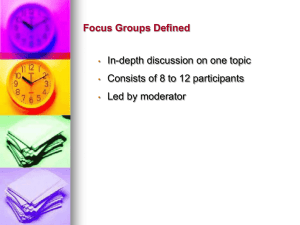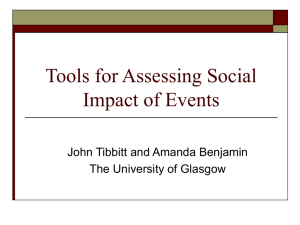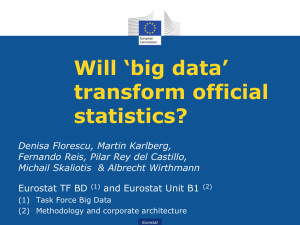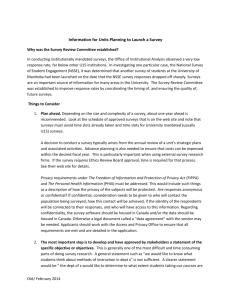Survey on Intellectual Property Products
advertisement
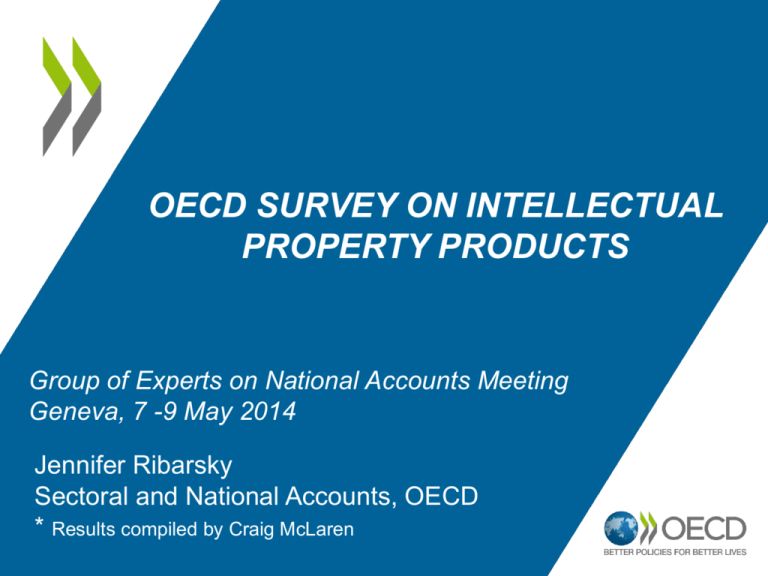
OECD SURVEY ON INTELLECTUAL PROPERTY PRODUCTS Group of Experts on National Accounts Meeting Geneva, 7 -9 May 2014 Jennifer Ribarsky Sectoral and National Accounts, OECD * Results compiled by Craig McLaren Background • 2008 SNA expands the asset boundary to include research and development (R&D) • Handbook on Deriving Capital Measures of Intellectual Property Products (OECD, 2010) • Detailed background and guidance • OECD questionnaire on IPPs • Covered: Research and Development, Mineral exploration and evaluation, Software and databases, Entertainment, Literary and Artistic originals Implementation of 2008 SNA • 6 OECD countries have implemented 2008 SNA and capitalised R&D – Australia, Canada, Israel, Korea, Mexico, and the United States include R&D in their national accounts • Implement by the end of 2014 All EUcountries, Iceland, Norway, Switzerland and New Zealand • 2015: Turkey • 2016: Chile and Japan Background ...within the National Accounts • Lot of focus on R&D • 2008 SNA / ESA 2010 Implementation • But other categories within IPP • OECD country survey covered these IPP categories • Summary of key issues from 23 countries Research and Development Expected impact • Based on country responses October 2012 • Five countries had not yet fully analysed the estimated impact No. of countries • Estimated impacts ranged from 0.5% to 3.5% of GDP with an average of around 1.7% of GDP 3 2 1 0 1 2 Percentage impact 3 Research and Development Sources and methods • A large number of countries have not needed new surveys, although a few countries captured new requirements by revising existing surveys • Main data sources used • Specific research and development surveys: e.g. GERD (gross domestic expenditure by government), BERD (gross domestic expenditure by business), and specific surveys for private non-profit bodies. • Examples of other sources: administrative data, e.g. universities and grant information, bank and tax records • Where data is not available on a regular annual basis, some countries use supplementary surveys for missing years, e.g. estimates from other surveys, administrative data, or extrapolation. Research and Development Sources and methods • All countries have implemented, or intend to follow, methods in the OECD manual and the Eurostat R&D task forces. • Where Frascati source data does not exist: • Some countries will use historical survey data and tax data to estimate the missing part of R&D activities, and/or transform it to the definitions according to the Frascati Manual, e.g. an adjustment for missing size classes and exhaustiveness. Research and Development Sources and methods • Examples of specific source and method issues: • Source limitations making it difficult to collect information about external funds to post graduate students • No information about trade margins, or taxes and subsidies on products and changes in inventories • For some countries all expenditures on R&D have been considered as providing a benefit • One country noted lags are not used, e.g. R&D is registered as an investment in the same period as production costs occur so there are no changes in inventories (an acceptable approach) Research and Development Depreciation • All countries use the PIM (or plan to) • Depreciation functions • Majority use Geometric; others are Linear, Winfrey • Mortality functions • Delayed linear, Double-declining, Log-normal, Truncated normal , Weibull Estimating service lives • Approaches can include use of data on average life of patents, surveys, econometric methods, other country’s assumption, or Eurostat default average service life • Work at Bureau of Economic Analysis (Wendy Li) uses relationship of R&D contribution to profitability http://search.oecd.org/officialdocuments/publicdisplaydocumentpdf/ ?cote=STD/CSTAT/WPNA%282012%297/ADD1&docLanguage=En • 7 out of 19 countries reported using the Eurostat default average service life of 10 years Research and Development Depreciation • Service lives examples • Service lives can differ based on the type and industry of R&D, e.g. 13 years (basic research), 11 years (applied research), 9 years (experimental development), and for specific industries: 7 years (computer programming), 9 years (electronics), and estimates of 15, 20 and 60 years (chemical and pharmaceutical products). • Examples of service lives for aggregate R&D were: 4.6 years, 6.2 years, 7 years, 8 years, 10 years, and 12 years. • Detailed service lives for a wide range of industries: Finland, Israel, and United States • Continuing research, e.g. Germany, Sweden and UK. R&D Service Lives: Pharmaceutical Manufacturing 25 20 Years 15 10 5 0 FI IL (minor) IL (major) NL US Eurostat default GB* (applied to all) Research and Development Specific issues • Historical data • Small number of countries have not decided on the approach • Where estimates do not exist the most common approach is the use of modelling. • For some countries, there is detail at a microeconomic level for recent years, but only macroeconomic data for earlier, so models will be used to derive back data. • Other approaches are: backcasting, interpolation or extrapolation based on relative or declining proportions, classification adjustments to align earlier data to earlier collected data. • Double counting • Nearly all countries take account of, or use approaches to minimise, double counting. • Some countries noted that information on this issue was not easily available, but for other countries it was not significant. Research and Development General issues • Issues raised included • Determining ownership, such as the treatment of R&D by multinational corporations. e.g. is the R&D produced mostly exports or domestic investments? • Integrating into calculations the treatment of consumption of fixed capital used for the production of new R&D results, as it can have an accelerating impact on R&D outputs • Ensuring consistency between different data sources, e.g. R&D surveys and structural business surveys • Choice and sensitivity of the deflation method • How to calculate the cost of capital in the R&D output as it could be sensitive to the choice of calculation • Capturing information on royalty payments Bonus non-R&D slides! – Mineral exploration and evaluation – Computer software and databases – Entertainment, literary or artistic originals Mineral exploration and evaluation Overview • The majority of countries derive estimates • Different types of data sources: • Surveys of the mining industry e.g. capital expenditure surveys, administrative data from government and industry groups, international trade statistics on exploration services, revenues and budgets • Methods used can differ greatly • Use of data directly from surveys or administrative datasets, sum of costs approach, pro-rating • Depreciation • All countries use PIM with different assumptions and service lives commonly used were: 10 years, 20 years and 30 years. Ranged from 1 – 40 years. • Implementation of SNA 2008 to update assumptions: service lives, depreciation functions,... Software and databases Overview • Previous OECD taskforce on software measurement (2002) • All responding countries compile estimates (or have plans to) • Wide range of data sources. Examples include • Specific surveys on Information and Communication Technology, administrative records, labour force surveys, e.g. hours worked on development, capital expenditure • Methods differ greatly between countries and can also be complex • Use of data directly from industry specific surveys or administrative data, production cost methods where labour and non-labour costs are estimated, e.g. using data such as wages, working hours, number of employees. • Depreciation: PIM, service lives commonly used were 4 or 5 years. • Issues • • • • Difficulty to separate databases from software in practice, enhancement of data sources Improving survey coverage for small businesses Distinguishing between databases which are fixed assets and those that are not Distinction between regular maintenance and software maintenance work to be considered as investment Entertainment, Literary and Artistic originals Overview • Majority of countries who responded compile estimates • Wide range of data sources • Industry specific data about royalties and royalty flows, for originals without an established system of royalty flows a production cost approach can be used, use of external experts such as patent offices and academics. • Methods differ greatly • Cost based valuation methods directly from data sources, use of royalties received as a proxy for the value of originals created, modelling relationships using data such as expenses, royalties or interest rates. • Depreciation: PIM, service lives commonly used were: 3, 5, 7 and 10 years. Some countries longer for certain types (e.g., around 20 years for theatrical movies in the US) • Issues • Coverage of the computer gaming industry • Recording transactions of Special Purpose Entities (SPEs) for royalties and licensing • Implementation of SNA 2008 to update assumptions: data sources to improve coverage, service lives, depreciation functions,... Summary • More details available in paper • Includes summary tables of country specific depreciation information for different IPPs • Thank you for your attention!
